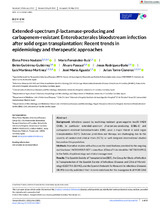Mostrar el registro sencillo del ítem
Extended-spectrum β-lactamase-producing and carbapenem-resistant Enterobacterales bloodstream infection after solid organ transplantation: Recent trends in epidemiology and therapeutic approaches
| dc.contributor.author | Pérez-Nadales, Elena | |
| dc.contributor.author | Fernández Ruiz, Mario | |
| dc.contributor.author | Gutiérrez Gutiérrez, Belén | |
| dc.contributor.author | Pascual, Álvaro | |
| dc.contributor.author | Rodríguez Baño, Jesús | |
| dc.contributor.author | Martínez-Martínez, Luis | |
| dc.contributor.author | Aguado, José María | |
| dc.contributor.author | Torre-Cisneros, Julián de la | |
| dc.date.accessioned | 2024-03-07T10:32:04Z | |
| dc.date.available | 2024-03-07T10:32:04Z | |
| dc.date.issued | 2022 | |
| dc.identifier.issn | 1399-3062 | |
| dc.identifier.uri | http://hdl.handle.net/10396/27640 | |
| dc.description.abstract | Background Infections caused by multidrug-resistant gram-negative bacilli (MDR GNB), in particular extended-spectrum β-lactamase-producing (ESBL-E) and carbapenem-resistant Enterobacterales (CRE), pose a major threat in solid organ transplantation (SOT). Outcome prediction and therapy are challenging due to the scarcity of randomized clinical trials (RCTs) or well-designed observational studies focused on this population. Methods Narrative review with a focus on the contributions provided by the ongoing multinational INCREMENT-SOT consortium (ClinicalTrials identifier NCT02852902) in the fields of epidemiology and clinical management. Results The Spanish Society of Transplantation (SET), the Group for Study of Infection in Transplantation of the Spanish Society of Infectious Diseases and Clinical Microbiology (GESITRA-SEIMC), and the Spanish Network for Research in Infectious Diseases (REIPI) recently published their recommendations for the management of MDR GNB infections in SOT recipients. We revisit the SET/GESITRA-SEIMC/REIPI document taking into consideration new evidence that emerged on the molecular epidemiology, prognostic stratification, and treatment of post-transplant ESBL-E and CRE infections. Results derived from the INCREMENT-SOT consortium may support the therapeutic approach to post-transplant bloodstream infection (BSI). The initiatives devoted to sparing the use of carbapenems in low-risk ESBL-E BSI or to repurposing existing non-β-lactam antibiotics for CRE in both non-transplant and transplant patients are reviewed, as well as the eventual positioning in the specific SOT setting of recently approved antibiotics. Conclusion Due to the clinical complexity and relative rarity of ESBL-E and CRE infections in SOT recipients, multinational cooperative efforts such as the INCREMENT-SOT Project should be encouraged. In addition, RCTs focused on post-transplant serious infection remain urgently needed. | es_ES |
| dc.format.mimetype | application/pdf | es_ES |
| dc.language.iso | eng | es_ES |
| dc.publisher | Wiley | es_ES |
| dc.rights | https://creativecommons.org/licenses/by/4.0/ | es_ES |
| dc.source | Transpl Infect Dis.;24:e13881 (2022) | es_ES |
| dc.subject | Antibiotics | es_ES |
| dc.subject | Carbapenem-resistant | es_ES |
| dc.subject | Enterobacterales | es_ES |
| dc.subject | Extended-spectrum β-lactamase-producing | es_ES |
| dc.subject | Enterobacterales | es_ES |
| dc.subject | INCREMENT-SOT Project | es_ES |
| dc.subject | Solid organ transplantation | es_ES |
| dc.subject | Treatmen | es_ES |
| dc.title | Extended-spectrum β-lactamase-producing and carbapenem-resistant Enterobacterales bloodstream infection after solid organ transplantation: Recent trends in epidemiology and therapeutic approaches | es_ES |
| dc.type | info:eu-repo/semantics/article | es_ES |
| dc.relation.publisherversion | https://doi.org/10.1111/tid.13881 | es_ES |
| dc.rights.accessRights | info:eu-repo/semantics/openAccess | es_ES |

